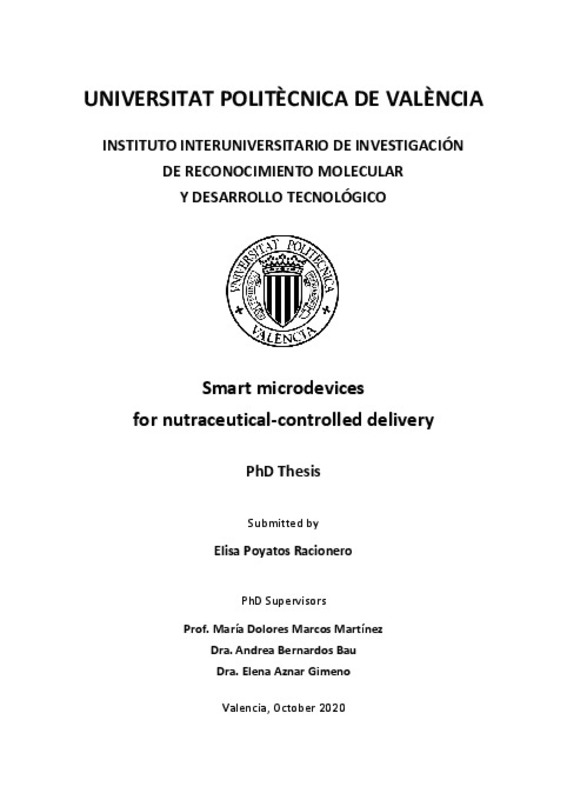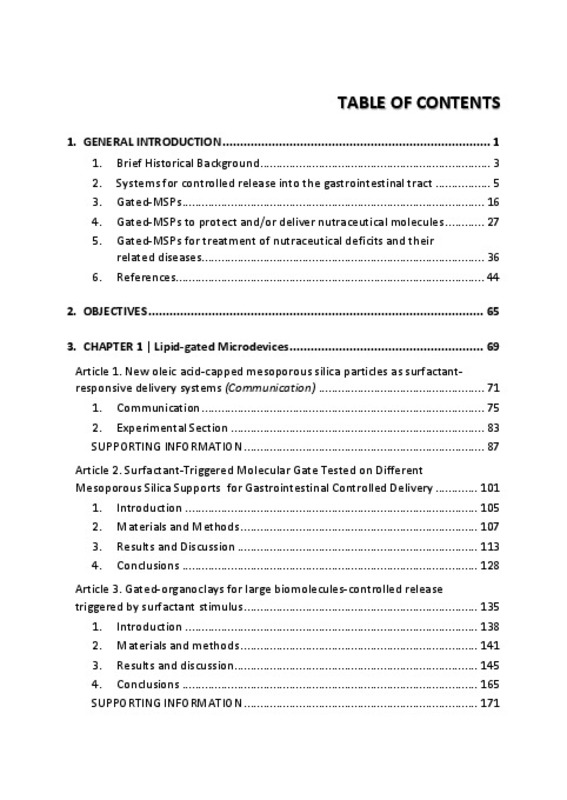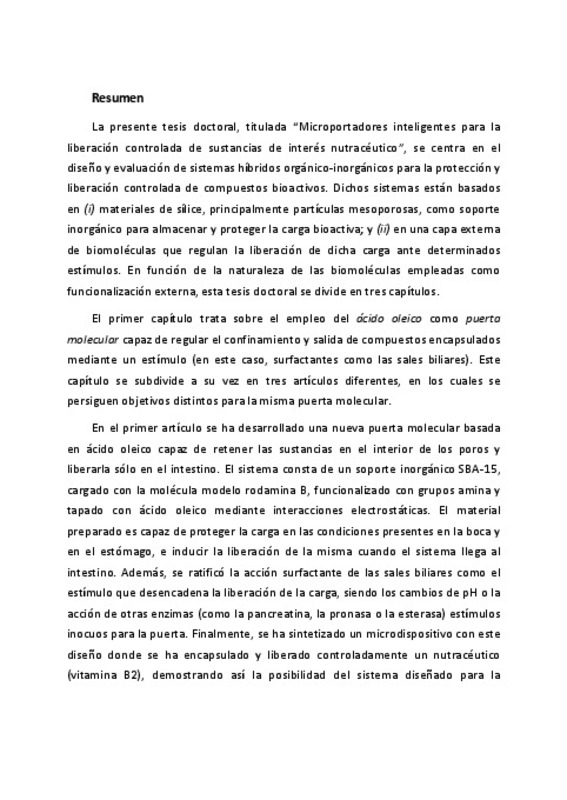- RiuNet repositorio UPV
- :
- Investigación
- :
- Tesis doctorales
- :
- Ver ítem
JavaScript is disabled for your browser. Some features of this site may not work without it.
Buscar en RiuNet
Listar
Mi cuenta
Estadísticas
Ayuda RiuNet
Admin. UPV
Smart microdevices for nutraceutical-controlled delivery
Mostrar el registro sencillo del ítem
Ficheros en el ítem
| dc.contributor.advisor | Aznar Gimeno, Elena
|
es_ES |
| dc.contributor.advisor | Bernardos Bau, Andrea
|
es_ES |
| dc.contributor.advisor | Marcos Martínez, María Dolores
|
es_ES |
| dc.contributor.author | Poyatos Racionero, Elisa
|
es_ES |
| dc.date.accessioned | 2021-01-18T10:31:21Z | |
| dc.date.available | 2021-01-18T10:31:21Z | |
| dc.date.created | 2020-12-11 | |
| dc.date.issued | 2021-01-17 | es_ES |
| dc.identifier.uri | http://hdl.handle.net/10251/159247 | |
| dc.description.abstract | [ES] La presente tesis doctoral, titulada "Microportadores inteligentes para la liberación controlada de sustancias de interés nutracéutico", se centra en el diseño y evaluación de sistemas híbridos orgánico-inorgánicos para proteger y liberar controladamente compuestos bioactivos. Dichos sistemas están basados en (i) materiales de sílice, principalmente partículas mesoporosas, como soporte inorgánico para almacenar y proteger la carga bioactiva; y (ii) una capa externa de biomoléculas como puerta molecular, que regula la liberación de la carga ante ciertos estímulos. En el primer capítulo de la tesis se describe el ácido oleico como puerta molecular. Este capítulo se subdivide en tres artículos diferentes, con distintos objetivos. En el primer artículo se emplea por primera vez el ácido oleico como puerta molecular de un soporte mesoporoso, cargado con la molécula modelo rodamina B. El material preparado es capaz de proteger la carga en las condiciones presentes en la boca y en el estómago, e inducir su liberación en el intestino con la acción surfactante de las sales biliares. El sistema se ha empleado para la liberación de vitamina B2, demostrando así la utilidad del diseño para la protección y liberación controlada de nutracéuticos. El segundo artículo evalúa la efectividad de esta puerta molecular en diferentes tipos de partículas mesoporosas de sílice, con diversos tamaños y estructuras de poro (MCM-41, MCM-48, SBA-15 y UVM-7). En todos los sistemas estudiados, la puerta molecular es capaz de mantener protegidas las moléculas cargadas, y liberarlas ante la presencia de sales biliares. El sólido basado en la estructura de UVM-7 se validó in vivo, observándose un retraso en la absorción intestinal de la rodamina gracias a su encapsulación. Por último, el tercer artículo incluido en este capítulo ha estudiado la posibilidad de incorporar puertas moleculares en filosilicatos. Se ha conseguido la protección y liberación controlada de biomoléculas de gran tamaño implicadas en el metabolismo humano (vitamina B12 y hematina) empleando filosilicatos funcionalizados con ácido oleico como puerta molecular. El segundo capítulo describe por primera vez el uso de la proteína zeína (prolamina de maíz) como puerta molecular. La presencia de la prolamina de maíz inhibe la salida de los compuestos antimicrobianos encapsulados (timol, carvacrol y cinamaldehído) liberándolos en presencia de las enzimas proteolíticas excretadas durante el crecimiento bacteriano. De todos los materiales desarrollados, el sistema cargado con cinamaldehído ha demostrado una inhibición del crecimiento de E. coli superior a la del compuesto libre. Finalmente, el tercer capítulo estudia la efectividad de la lactosa como puerta molecular para proteger aceites esenciales y liberarlos solo en las condiciones presentes en el intestino. Se han preparado tres materiales diferentes basados en MCM-41, cargados con timol, eugenol y cinamaldehído, y funcionalizados con lactosa para inhibir la salida de los compuestos. La acción enzimática de la lactasa secretada en el intestino es capaz de hidrolizar la puerta molecular en los correspondientes monosacáridos, liberando la carga a lo largo del lumen intestinal. Los microdispositivos diseñados han sido validados in vitro con células Caco-2, donde se ha observado el aumento de la capacidad citotóxica del cinamaldehído y la disminución de la permeabilidad a través del modelo de membrana intestinal gracias a su encapsulación. Finalmente, el microdispositivo cargado con cinamaldehído se ha validado in vivo ratificándose la disminución de la permeabilidad del compuesto y su mayor permanencia en el lumen intestinal. Así, la presente tesis doctoral ha demostrado la posibilidad de emplear biomoléculas sencillas de grado alimentario como puertas moleculares sobre diversos materiales de sílice. Estos nuevos sistemas han permitido proteger y liberar control | es_ES |
| dc.description.abstract | [CA] La present tesi doctoral, titulada "Microportadors intel·ligents per a l'alliberament controlat de substàncies d'interès nutracèutic", se centra en el disseny i avaluació de sistemes híbrids orgànic-inorgànics per a la protecció i alliberament controlat de compostos bioactius. Aquests sistemes estan basats en (i) materials de sílice, principalment partícules mesoporoses, com a suport inorgànic per emmagatzemar i protegir la càrrega bioactiva; i (ii) una capa externa de biomolècules com a porta molecular, que regula l'alliberament d'aquesta càrrega davant de determinats estímuls. En el primer capítol de la tesi es descriu l'àcid oleic com a porta molecular. Aquest capítol se subdivideix en tres articles diferents, amb objectius diferents. En el primer article s'empra per primera vegada l'àcid oleic com a porta molecular d'un suport mesoporós, carregat amb la molècula model rodamina B. El material preparat és capaç de protegir la càrrega en les condicions presents a la boca i a l'estómac, i induir el seu alliberament a l'intestí amb l'acció surfactant de les sals biliars. El sistema s'ha emprat per a l'alliberament de vitamina B2, demostrant així la utilitat del disseny per a la protecció i alliberament controlat de nutracèutics. El segon article avalua l'efectivitat d'aquesta porta molecular en diferents tipus de partícules mesoporoses de sílice, amb diverses mides i estructures de porus (MCM-41, MCM-48, SBA-15 i UVM-7). En tots els sistemes estudiats, la porta molecular és capaç de mantindre protegides les molècules carregades, i alliberar-les davant la presència de sals biliars. El sòlid basat en l'estructura de UVM-7 es validà in vivo, observant-se un retard en l'absorció intestinal de la rodamina gràcies a la seua encapsulació. Finalment, en el tercer article inclòs en aquest capítol s'ha estudiat la possibilitat d'incorporar portes moleculars en fil·losilicats. S'ha aconseguit la protecció i alliberament controlat de biomolècules de grans dimensions implicades en el metabolisme humà (vitamina B12 i hematina) emprant fil·losilicats funcionalitzats amb àcid oleic com a porta molecular. El segon capítol descriu per primera vegada l'ús de la proteïna zeïna (prolamina de dacsa) com a porta molecular. La presència de la prolamina de dacsa inhibeix la sortida dels compostos antimicrobians encapsulats (timol, carvacrol i cinamaldèhid) alliberant-los en presència dels enzims proteolítics excretades durant el creixement bacterià. De tots els materials desenvolupats, el sistema carregat amb cinamaldèhid ha demostrat una inhibició de l'creixement d'E. coli superior a la del compost lliure. Finalment, el tercer capítol estudia l'efectivitat de la lactosa com a porta molecular per protegir olis essencials i alliberar-los només en les condicions presents a l'intestí. S'han preparat tres materials diferents basats en MCM-41, carregats amb timol, eugenol i cinamaldèhid, i funcionalitzats amb lactosa per inhibir l'eixida dels compostos. L'acció enzimàtica de la lactasa secretada a l'intestí és capaç d'hidrolitzar la porta molecular en els corresponents monosacàrids, alliberant la càrrega al llarg del lumen intestinal. Els microdispositius dissenyats s'han validat in vitro amb cèl·lules Caco-2, on s'observà l'augment de la capacitat citotòxica del cinamaldèhid i la disminució de la permeabilitat a través del model de membrana intestinal gràcies a la seua encapsulació. Finalment, el microdispositiu carregat amb cinamaldèhid s'ha validat in vivo ratificant la disminució de la permeabilitat del compost i la seua major permanència al lumen intestinal. Així, la present tesi doctoral ha demostrat la possibilitat d'emprar biomolècules senzilles de grau alimentari com portes moleculars sobre diversos materials de sílice. Aquests nous sistemes han permès protegir i alliberar controladament diferents nutracèutics, millorant així la seua biodisponibilitat. | es_ES |
| dc.description.abstract | [EN] This PhD thesis, entitled "Smart microdevices for nutraceutical-delivery", is focused on the design and evaluation of organic-inorganic hybrid systems for the protection and controlled release of bioactive molecules. These systems are based on (i) silica materials, mainly mesoporous particles, as inorganic support to store and protect the bioactive cargo; and (ii) an outer layer of biomolecules that regulate the payload release triggered by certain stimuli. In the first chapter of the thesis oleic acid is described as a molecular gate. This chapter is subdivided into three different articles, with different objectives. In the first article, oleic acid is used for the first time as molecular gate of a mesoporous support, loaded with the rhodamine B model molecule. The designed material is capable of protecting the cargo under the conditions present in the mouth and stomach, and inducing its release in the small intestine with the surfactant action of bile salts. The system has been used for the release of vitamin B2, thus demonstrating the validity of the design for the protection and controlled release of nutraceuticals. The second article evaluates the effectiveness of this molecular gate in different types of mesoporous silica particles, with different sizes and pore structures (MCM-41, MCM-48, SBA-15 and UVM-7). In all the systems studied, the molecular gate is capable of keeping cargo molecules protected and releasing them in the presence of bile salts. The solid based on the structure of UVM-7 was validated in vivo, observing a delay in the intestinal absorption of rhodamine thanks to its encapsulation. Lastly, the third article included in this chapter has studied the possibility of incorporating molecular gates onto phyllosilicates. The protection and controlled release of large biomolecules involved in human metabolism (vitamin B12 and hematin) have been achieved using phyllosilicates functionalized with oleic acid as molecular gate. The second chapter describes for the first time the use of the protein zein (corn prolamine) as a molecular gate. The presence of corn prolamine inhibits the release of encapsulated antimicrobial compounds (thymol, carvacrol and cinnamaldehyde) releasing them in the presence of the proteolytic enzymes excreted during bacterial growth. Among all the materials developed, the cinnamaldehyde-loaded system has shown greater inhibition of E. coli growth than the free compound. Finally, the third chapter studies the effectiveness of lactose as a molecular gate to protect essential oils and release them only under the conditions present in the intestine. Three different materials based on MCM-41 loaded with thymol, eugenol, and cinnamaldehyde, and functionalized with lactose to inhibit the release of the compounds have been prepared. The enzymatic action of the lactase secreted in the intestine is capable of hydrolyzing the molecular gate into the corresponding monosaccharides, thus releasing the cargo along the intestinal lumen. The designed microdevices have been validated in vitro with Caco-2 cells, where an increase in the cytotoxic capacity of cinnamaldehyde and a decrease in permeability through the intestinal membrane model have been observed thanks to its encapsulation. Finally, the cinnamaldehyde-loaded microdevice has been validated in vivo, confirming the decrease in the permeability of the compound and its greater permanence in the intestinal lumen. Thus, the present PhD thesis has demonstrated the possibility of using simple food-grade biomolecules as gatekeepers on various silica materials. These new systems have allowed the protection and controlled release of different nutraceuticals, thus improving their bioavailability. | es_ES |
| dc.description.sponsorship | The authors also thank the Electron Microscopy Service at the UPV for support. The authors also thank Prof. Pedro Amorós for his explanations and guidance on the knowledge of phyllosilicates. | es_ES |
| dc.format.extent | 312 | es_ES |
| dc.language | Inglés | es_ES |
| dc.publisher | Universitat Politècnica de València | es_ES |
| dc.rights | Reserva de todos los derechos | es_ES |
| dc.subject | Materiales de sílice | es_ES |
| dc.subject | Partículas mesoporosas | es_ES |
| dc.subject | Organoarcillas | es_ES |
| dc.subject | Puerta molecular | es_ES |
| dc.subject | Estímulo | es_ES |
| dc.subject | Liberación controlada | es_ES |
| dc.subject | Liberación gastrointestinal | es_ES |
| dc.subject | Ácido oleico | es_ES |
| dc.subject | Sales biliares | es_ES |
| dc.subject | Proteína | es_ES |
| dc.subject | Zein | es_ES |
| dc.subject | Lactosa | es_ES |
| dc.subject | Beta galactosidasa | es_ES |
| dc.subject | Lactasa | es_ES |
| dc.subject | Nutracéutico | es_ES |
| dc.subject | Antimicrobiano | es_ES |
| dc.subject | Vitaminas | es_ES |
| dc.subject | Componentes de aceites esenciales | es_ES |
| dc.subject | Biodisponibilidad | es_ES |
| dc.subject | Mesoporous silica | |
| dc.subject | Organoclay | |
| dc.subject | Molecular gate | |
| dc.subject | Controlled release | |
| dc.subject | Nutraceutical | |
| dc.subject | Antimicrobial | |
| dc.subject | Bioavailability | |
| dc.subject | Lactase | |
| dc.subject | Lactose | |
| dc.subject.classification | CIENCIA DE LOS MATERIALES E INGENIERIA METALURGICA | es_ES |
| dc.subject.classification | QUIMICA INORGANICA | es_ES |
| dc.subject.classification | QUIMICA ANALITICA | es_ES |
| dc.title | Smart microdevices for nutraceutical-controlled delivery | es_ES |
| dc.type | Tesis doctoral | es_ES |
| dc.identifier.doi | 10.4995/Thesis/10251/159247 | es_ES |
| dc.relation.projectID | info:eu-repo/grantAgreement/MINECO//MAT2015-64139-C4-1-R/ES/NANOMATERIALES INTELIGENTES, SONDAS Y DISPOSITIVOS PARA EL DESARROLLO INTEGRADO DE NUEVAS HERRAMIENTAS APLICADAS AL CAMPO BIOMEDICO/ | es_ES |
| dc.relation.projectID | info:eu-repo/grantAgreement/MINECO//AGL2015-70235-C2-1-R/ES/SISTEMAS HIBRIDOS BASADOS EN SOPORTES BIOCOMPATIBLES PARA EL DESARROLLO DE ANTIMICROBIANOS A PARTIR DE SUSTANCIAS NATURALES Y LIBERACION CONTROLADA DE COMPUESTOS ALIMENTARIOS/ | es_ES |
| dc.relation.projectID | info:eu-repo/grantAgreement/MINECO//AGL2015-70235-C2-2-R/ES/DESARROLLO DE SISTEMAS HIBRIDOS CON OPTIMIZACION DEL ANCLADO DE BIOMOLECULAS Y DISEÑADOS CON PROPIEDADES DE ENCAPSULACION Y LIBERACION CONTROLADA MEJORADAS/ | es_ES |
| dc.relation.projectID | info:eu-repo/grantAgreement/GVA//PROMETEO%2F2018%2F024/ES/Sistemas avanzados de liberación controlada/ | es_ES |
| dc.relation.projectID | info:eu-repo/grantAgreement/GVA//ACIF%2F2016%2F023/ | es_ES |
| dc.relation.projectID | info:eu-repo/grantAgreement/GVA//APOSTD%2F2019%2F118/ | es_ES |
| dc.relation.projectID | info:eu-repo/grantAgreement/AEI/Plan Estatal de Investigación Científica y Técnica y de Innovación 2017-2020/RTI2018-100910-B-C41/ES/MATERIALES POROSOS INTELIGENTES MULTIFUNCIONALES Y DISPOSITIVOS ELECTRONICOS PARA LA LIBERACION DE FARMACOS, DETECCION DE DROGAS Y BIOMARCADORES Y COMUNICACION A NANOESCALA/ | es_ES |
| dc.relation.projectID | info:eu-repo/grantAgreement/AEI//RTI2018‐101599‐B‐C22/ES/DESARROLLO Y APLICACION DE SISTEMAS ANTIMICROBIANOS PARA LA INDUSTRIA ALIMENTARIA BASADOS EN SUPERFICIES FUNCIONALIZADAS Y SISTEMAS DE LIBERACION CONTROLADA/ | es_ES |
| dc.relation.projectID | info:eu-repo/grantAgreement/AEI/Plan Estatal de Investigación Científica y Técnica y de Innovación 2017-2020/RTI2018-101599-B-C21/ES/DESARROLLO Y APLICACION DE SISTEMAS ANTIMICROBIANOS PARA LA INDUSTRIA ALIMENTARIA BASADOS EN SUPERFICIES FUNCIONALIZADAS Y SISTEMAS DE LIBERACION CONTROLADA/ | es_ES |
| dc.relation.projectID | info:eu-repo/grantAgreement/MINECO//SAF2016-78756-P/ES/MODELOS IN VITRO DE EVALUACION BIOFARMACEUTICA: BARRERAS BIOLOGICAS Y DISOLUCION BIOPREDICTIVA/ | es_ES |
| dc.rights.accessRights | Abierto | es_ES |
| dc.contributor.affiliation | Universitat Politècnica de València. Departamento de Química - Departament de Química | es_ES |
| dc.description.bibliographicCitation | Poyatos Racionero, E. (2020). Smart microdevices for nutraceutical-controlled delivery [Tesis doctoral]. Universitat Politècnica de València. https://doi.org/10.4995/Thesis/10251/159247 | es_ES |
| dc.description.accrualMethod | TESIS | es_ES |
| dc.type.version | info:eu-repo/semantics/acceptedVersion | es_ES |
| dc.relation.pasarela | TESIS\10983 | es_ES |
| dc.contributor.funder | Ministerio de Economía y Competitividad | es_ES |
| dc.contributor.funder | Generalitat Valenciana | es_ES |
| dc.contributor.funder | Agencia Estatal de Investigación | es_ES |
Este ítem aparece en la(s) siguiente(s) colección(ones)
-
Tesis doctorales [5389]










